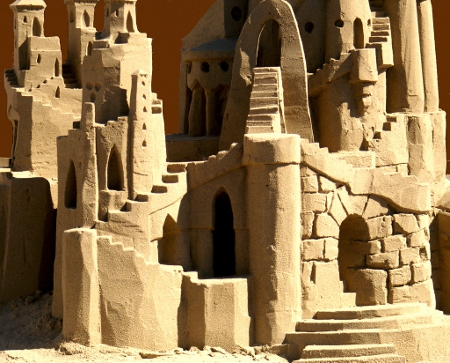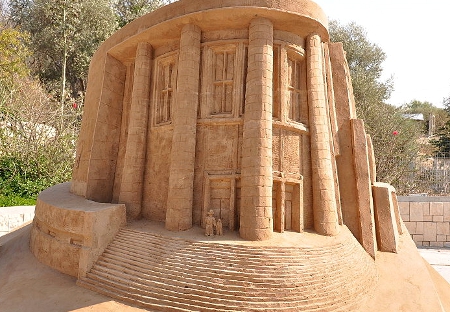Lesson: Sand and Water

( Castles in the Sand lesson courtesy of Great Sand Dunes National Park and Preserve, Colorado) Level: Grades 3 – 8. Group size: three to eight. Time required: 45 minutes, plus time spent traveling to the location.
Castles in the Sand
If you’re fortunate enough to live near a beach or sandy banks or dunes, this sand-castle construction lesson from the Great Sand Dunes National Park and Preserve will both instruct and entertain, helping your students understand the cohesive force of water tension and the adhesive force of capillary action.
Colorado State Standards
Science Standard 1 – Students understand the processes of scientific investigation and design, conduct, communicate about, and evaluate such investigations.
Science Standard 2.1 – Students know and understand common properties, forms, and changes in matter and energy. Specifically, students know that matter has characteristic properties, which are related to its composition and structure.
Science Standard 4.1 – Students know and understand the processes and interactions of Earth’s systems and the structure and dynamics of Earth and other objects in space. Specifically, students know and understand the composition of Earth, its history, and the natural processes that shape it.
Science Standard 4.3 – Students know major sources of water, its uses, importance, and cyclic patterns of movement through the environment.
Materials
Various buckets, cups, scoops, and small shovels. Sand and water.
Vocabulary
Capillary Action — Through the adhesive forces (sticky property) of water, water is able to move through tiny spaces. Capillary action describes the moisture transfer through which the water is sucked into those spaces in and between building materials, caused by the attraction of water molecules to each other and to other substances.
Surface Tension — The attractive forces between water molecules creates what is called surface tension. Surface tension creates a strong boundary between the air and water, which allows some insects to walk on water and keeps water from evaporating too quickly.
Learner Outcome
Students will learn about the cohesive force of water tension and the adhesive force of capillary action.
Background
One of the more special properties of water is its “stickiness.” Because of attractive intermolecular forces, water beads up on waxy surfaces, it travels upwards through the trunk of a tree, and some insects are able to walk across its surface.
Two types of forces contribute to water’s stickiness: cohesive and adhesive forces.
Cohesive forces create the attraction between individual water molecules. These forces contribute to surface tension. Surface tension allows water strider insects to move almost effortlessly Water strider on water across a creek’s surface without sinking. Surface tension keeps water from quickly evaporating from lakes. Without surface tension, the morning dew could not bead up on spider webs.
Through adhesive forces, water is attracted between unlike molecules. Look closely, for example, at water rising up the sides of a thin glass tube. This adhesive attraction is even greater than water’s cohesive force (which causes surface tension).
Water’s adhesion to other surfaces, such as sand grains, causes a flow called capillary action. Capillary action helps water rise to the top of the highest trees, helps water flow through some aquifers, helps transport nutrients throughout your body, and allows the billions of sand grains in a sand castle to stick together.
1. Find a beach or sand dune destination that offers two separate working areas: one near where water is flowing and the other in a dry, sandy area. Students can work in groups small or large.
2. Explain to the students that they are going to have a sand-castle building competition. Distribute the supplies and tell them they will have twenty minutes to build their castles. First have them build castles in the area of dry sand. The only rule is that they cannot leave their building site.
3. In a short while, students will begin complaining that the dry sand will not hold castle walls. Before they get too frustrated, ask them to consider what would help them in their castle-building endeavor. Explain the concepts of water tension and capillary action. Then have the groups move to the location with wet sand alongside the creek.
4. Allow twenty minutes for students to build their castles with wet sand. When the time is up, inspect each castle and discuss the effects of water on the castles. Let the students share the problems and ideas they had while building. Have them consider further special structural effects they could introduce, and how to achieve them. What kinds of structural challenges do engineers face in building, and how do they overcome them?
Critical Thinking
Make a list of things in nature or things made by people that would not work without surface tension or capillary action.
Extension
Sand Filters is a follow-up activity that helps students understand how capillary action filters water naturally.
Filed under: Grades 6-8, Grades 6-8, Grades K-5, Grades K-5, K-12 Outreach Programs, Lesson Plans
Tags: capillary action, Chemical Engineering, erosion, Grades 3-8, Great Sand Dunes National Park, Lesson Plan, sand and water, Water









